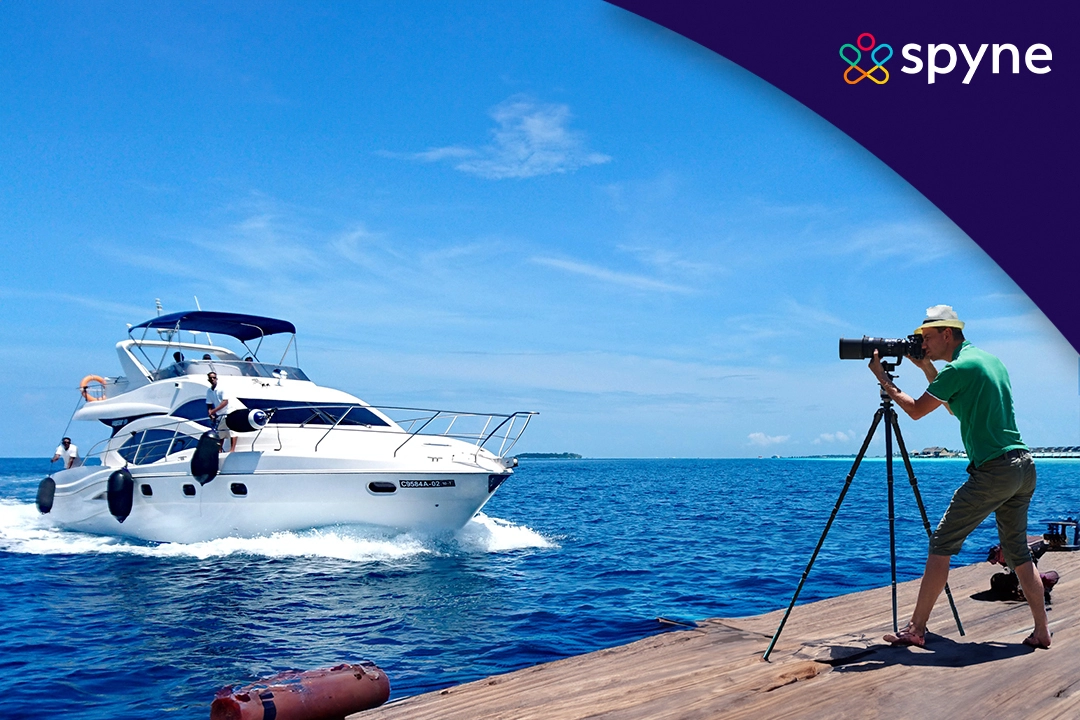Welcome to the world of boat photography, where we’ll make creating amazing boat pictures super easy! Get ready for simple tips that turn sails into works of art. Navigate through the variation of location-based photography and gain insights into essential considerations. Whether you’re a business or an individual setting sail, this comprehensive guide is your compass to capturing the essence of boats in every frame. No need for fancy stuff – just straightforward advice for those starting. Plus, we’ll help you pick the perfect camera and lens.
What is Boat Photography?
Boat photography is a specialized type of photography that focuses on capturing the beauty and essence of boats and their surroundings. It encompasses a wide range of styles and techniques, from capturing stunning landscapes with boats as the focal point to showcasing the intricate details and craftsmanship of a vessel. It’s all about the details in sea photography, the texture, the features, the comforts, and the essence boating brings. So, grab your camera, head to the water, and let’s capture some amazing boat moments!
Boat Photography Techniques
To create amazing sail visuals, Here are some boat photography techniques explained in more detail:
1) Focus on the Sail: The sail is a key element in boat photography. Capture its curves, textures, and how it interacts with the wind. Zoom in to highlight details, or step back to include the entire sail in the frame. Adjust your focus to ensure the sailboat photography is sharp and well-defined.
2) Fast Shutter Speed: Use a fast shutter speed to freeze the action and avoid motion blur. This is crucial when photographing moving boats, especially in dynamic conditions. A shutter speed of 1/500s or faster is generally recommended, but adjust as needed based on the speed of the boat and lighting conditions.
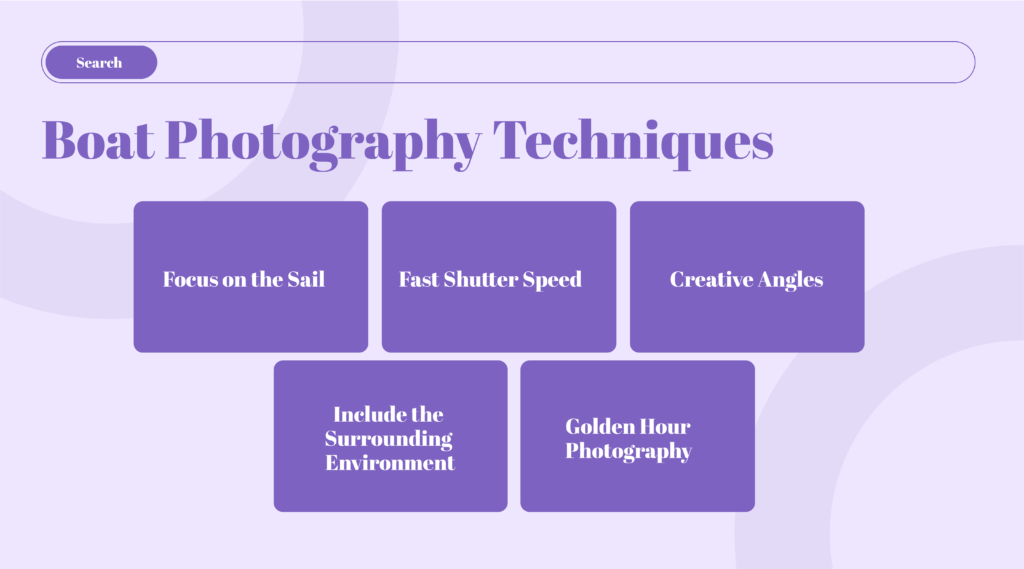
3) Creative Angles: Experiment with different angles to add interest to your boat photos. Shooting from the water level can provide a unique perspective, as can capturing the vessel from the bow. Climbing to higher vantage points or using drone boat photography can also offer fresh and captivating viewpoints.
4) Include the Surrounding Environment: Showcase the natural beauty of the sea by including the surrounding environment in your shots. This not only provides context but also adds depth and a sense of scale to your images. Consider using a wide-angle lens to capture the expansive seascape.
5) Golden Hour Photography: Take advantage of the golden hour for soft, warm light that enhances the beauty of the scene. The low angle of the sun during sunrise or sunset can cast long shadows and create a pleasing atmosphere. This is an ideal time to capture the sailboat against a stunning backdrop.
Remember to adapt these techniques based on the specific conditions and your creative vision. Experimenting with different approaches will help you develop your style and capture stunning boat photography.
Top Boat Photography Tips
For capturing stunning boat photography it is important to understand the key elements of best boat photography tips:
1) Choose the Best Location
- Find a location that offers a perfect background, such as a scenic coastline, a beautiful harbor, or a tranquil lake. The surroundings can greatly enhance the visual appeal of photographs of boats.
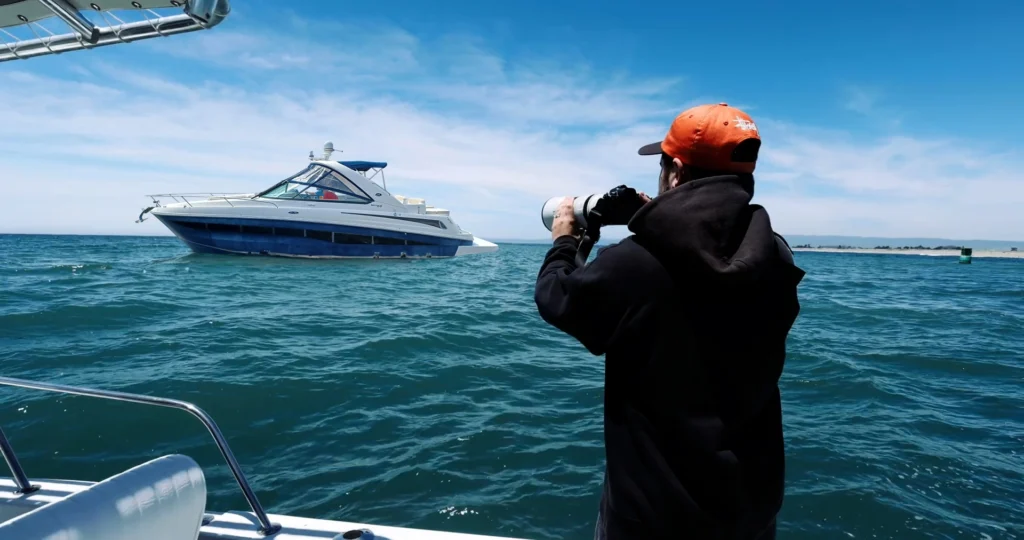
- Choose the best time of day for the warm lighting. Early morning and late afternoon provide soft, warm light that can add a magical touch to your images.
2) Best Camera Equipment
- Use a camera with good resolution and image quality. A DSLR or a mirrorless camera with a variety of lenses can help you capture boats from different perspectives.
- If you’re shooting from another boat or in challenging conditions, consider using a telephoto lens to zoom in on details. A wide-angle lens can be great for capturing the boat in its environment.
3) Best Camera Settings for Boat Photography
- Low ISO: Use a low ISO in bright light to maintain sharpness and reduce noise in your photos.
- Fast Shutter Speed: For capturing boats in motion, use a fast shutter speed to freeze the action.
- Aperture Priority or Manual Mode: Consider using Aperture Priority or Manual mode to have control over both aperture and shutter speed or just use an AI photo editor.
4) Best Composition for Boat Photograph
- Rule of Thirds: Place the boat or key elements along the lines or intersections of the rule of thirds grid for a balanced composition.
- Leading Lines: Use natural elements like water lines, reflections, or the boat itself to create leading lines that draw the viewer’s eyes into the photo.
- Foreground Interest: Include interesting foreground elements like rocks, waves, or other boats to add depth and context to your composition.
- Consider Angles: Experiment with shooting from different angles – ground level, from a higher vantage point, or even from the boat itself – to find unique perspectives.
Remember to experiment with these tips and adjust your approach based on the specific conditions and the style you want to achieve in your boat photography.
Additional tips for boat photography
1) Consider a dry bag for your photo gear. Sudden waves or rain can damage your equipment.
2) Keep a fast shutter speed. This will help capture sharp images of moving boats and prevent motion blur.
3) Bring plenty of battery power and memory card space. Shooting on a boat often involves limited access to charging and storage.
4) Understand lighting. The golden hours of dawn and dusk offer soft, warm light for stunning reflections.
5) Pay attention to wind and distortion. Wind can cause waves and choppy water, while distortion can occur when shooting through windows.
6) Shooting platforms. Consider different shooting platforms to capture unique perspectives, such as from the deck, mast, or even a drone.
7) Frame compositions thoughtfully. Use the rule of thirds, leading lines, and other compositional techniques to create visually appealing images.
Best Boat Photography Ideas
Capture stunning boat photos with unique angles. Try shots from the deck to show off the boat up close. Explore water-level views for a different look, or use a drone for cool shots from above. Aerial photos make the boat stand out in its surroundings. Get creative, whether it’s close-ups or wide shots, playing with angles turns your boat into a beautiful picture. Don’t stick to the usual, keep experimenting with different perspectives and discovering the art in every photo.
Types of Boat Photography
Various types of boat photography have their different opportunities and qualities to enhance the visual appeal of the sail let’s explore these different types of boat photography in detail:
1) Action Boat Photography: This type of photography captures the boat in action or motion to enhance the beauty of the boat.
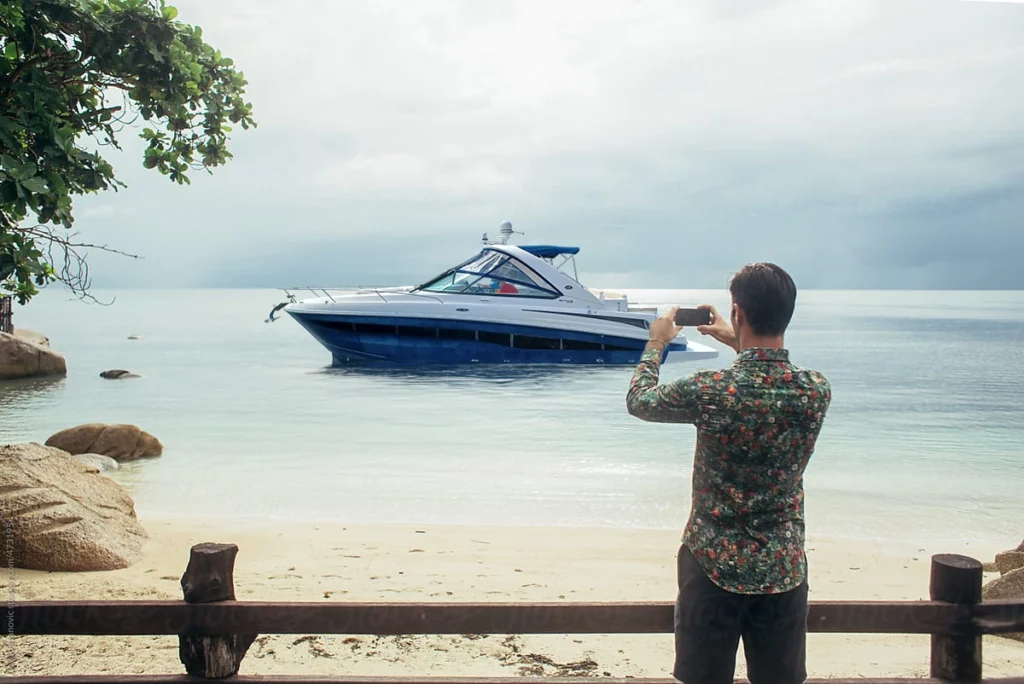
2) Boat Landscape Photography: This type of photography uses boats to add interest and scale to landscape images. It can be used to create a sense of depth and perspective or to highlight the natural beauty of a location.
3) Portrait Boat Photography: This type of photography focuses on capturing the personality or characteristics of the person or people on the boat.
4) Close-up Boat Photography: This type of photography on boat usually captures close-up shots of the boat parts interior and exterior shots.
5) Aerial Boat Photography: This type of boat photography captures the boat from above or on top with the help of drones and helicopters.
6) Night Boat Photography: This type of photography is shot during the night to capture the beauty and mystery of the boat at night.
7) Underwater Boat Photography: This type of photography takes underwater shots of boats to capture the underwater surroundings of the boat.
The best type of boat photography for you will depend on your interests and goals. Experiment with different styles and techniques to find what you enjoy most.
Choose The Right Camera for Boat Photography
Choosing the right camera for boat photography is essential you must choose the right camera Here we are going to mention some of the best cameras so that you can choose the right one according to your preferences:
| Camera | Description | Pricing |
| Olympus Tough TG-6 | Waterproof, shockproof, and freezeproof, ideal for underwater and action shots. | $499.99 |
| FujiFilm Quicksnap Waterproof | Disposable waterproof camera for carefree shooting | $14.99 |
| GoPro Hero8 Black | Durable action camera with wide-angle lens and 4K video capture | $299 |
| Ricoh WG-70 | Excellent waterproof and shockproof performance, good image quality for the price | $309 |
| SeaLife Micro 3.0 Digital Underwater Camer | Compact and lightweight underwater camera with macro capabilities | $599 |
| Kodak PixPro WPZ2 Digital Camera | Affordable waterproof camera with built-in GPS and Wi-Fi | $179 |
| Sony Alpha 1 and Ikelite 200DL | Professional full-frame camera with exceptional image quality for serious photographers | $6,498 |
| Sony RXO II | Small and waterproof pocket camera with high-resolution sensor and 180° flip-up display | $698 |
| MOOCOR 7” Underwater Fishing Camera | Waterproof, portable carrying case and 1080P HD camera | $209.99 |
| Barlus Camera Underwater 5MP | Waterproof, 5MP Camera 304 Stainless Steel IP68 | $265.00 |
Things to Consider When Photographing Boats
There are various considerations when it comes to capturing stunning boat visuals manually including a great understanding of lighting, and always choosing the right equipment for boat photographs. Frame composition thoughtfully experiments with different angles, and captures candid visuals, paying close attention to details, trying out different filters that include people and tell a story, and finally practicing patience because great shots require time and a lot of patience.
Lenses for Boat Photography
When it comes to boat photography, choosing the right lenses can greatly enhance your ability to capture stunning images. consider a variety of diverse shots. For harbor scenes or marinas, a wide-angle lens (around 24-28mm) is ideal, capturing all-encompassing shots with straight lines and accurate perspective.
For close-up details on boats, a prime lens like the 50mm f/1.8 is excellent. It’s perfect for capturing intricate elements such as ropes, anchors, and navigation controls. A macro lens can further enhance fine details.
When photographing distant boats or sailing scenes, opt for a telephoto lens with flexible focal lengths, such as 70-200mm or 70-300mm. This allows you to zoom in for close-ups or frame wider shots as needed.
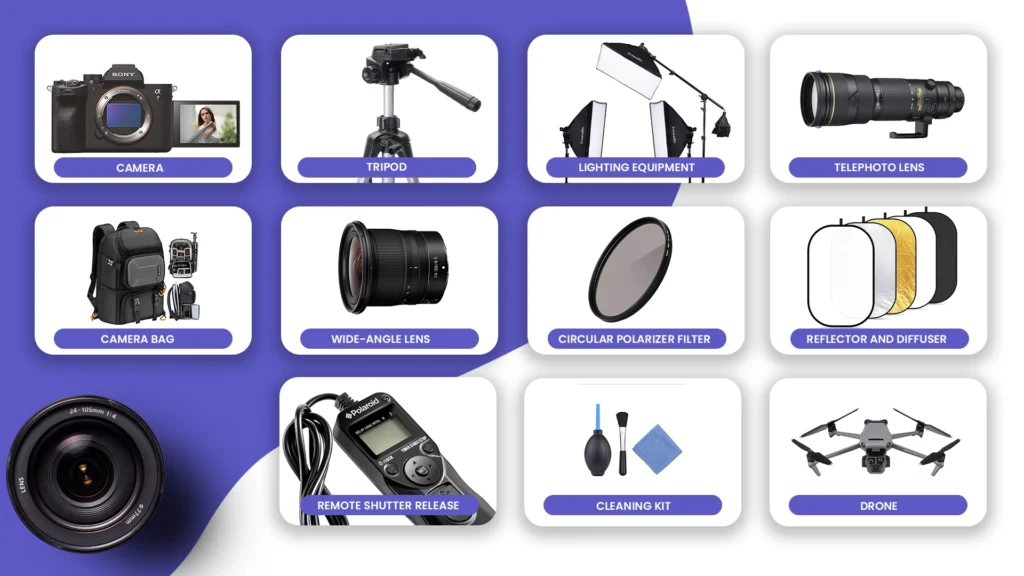
Additional Equipment: Tripods, Filters, Stabilization
In addition to your camera and lens, some additional boat photography props can significantly enhance your boat photography experience. A tripod can be Ideal for capturing distant boats with a long telephoto lens. Polarizing filters are a great option if you want to reduce glare and reflections. Try out UV filters to Protect your lens from water and salt splashes, which can be damaging.
You can go for a monopod if you can move around and still offers good stabilization.
How Spyne Can Transform Boat Photography?
Spyne revolutionizes boat photography through its AI-powered platform, delivering a remarkable 100% enhancement in visual cataloging. With advanced deep learning algorithms, It transforms boat imagery, offering a range of features:
1) Dynamic Backgrounds: Utilize the AI-powered virtual photography platform to effortlessly create new backgrounds. Replace outdated settings or choose from an extensive library of 100+ backgrounds to enhance the visual appeal of boat images.
2) Immersive 360-Degree Spin: Engage your audience with compelling product videos using the 360-degree spin feature. This functionality allows viewers to rotate and explore boats from every conceivable angle, providing a comprehensive view of both the exterior and interior. Ideal for online showcases and creating a more immersive customer experience.
3) Efficient Batch Processing: Streamline your workflow with its batch processing capability. Easily handle multiple boat images in one go, saving time and ensuring consistent quality across your entire catalog.
4) Simplified Photo Editing: It makes photo editing a breeze. No need for professional photographers, expensive equipment, or additional staff. Achieve impressive results with just a smartphone, empowering individuals and businesses to create stunning boat visuals independently.
5) AI Enhancement: Benefit from its AI-driven enhancement that goes beyond basic editing. Upgrade the quality of boat photos to a professional level, ensuring that each image stands out and leaves a lasting impression.
Its transformative platform empowers you to elevate your boat photography effortlessly, combining cutting-edge technology with user-friendly features for visually striking results.
Conclusion
Dive into boat photography without any worries with our easy guide. Learn simple tips, styles, and gear suggestions. Spyne’s AI easily makes your boat photos better. Just grab your camera, sail away, and take pictures to tell a beautiful water story. Whether you’re a beginner or an experienced photographer, enjoy the journey where creativity meets simplicity. So, go ahead, click some photos, and capture the beauty of the water. With easy tips and an AI platform, your boat photography can be a joyful experience, turning every shot into a delightful memory.

